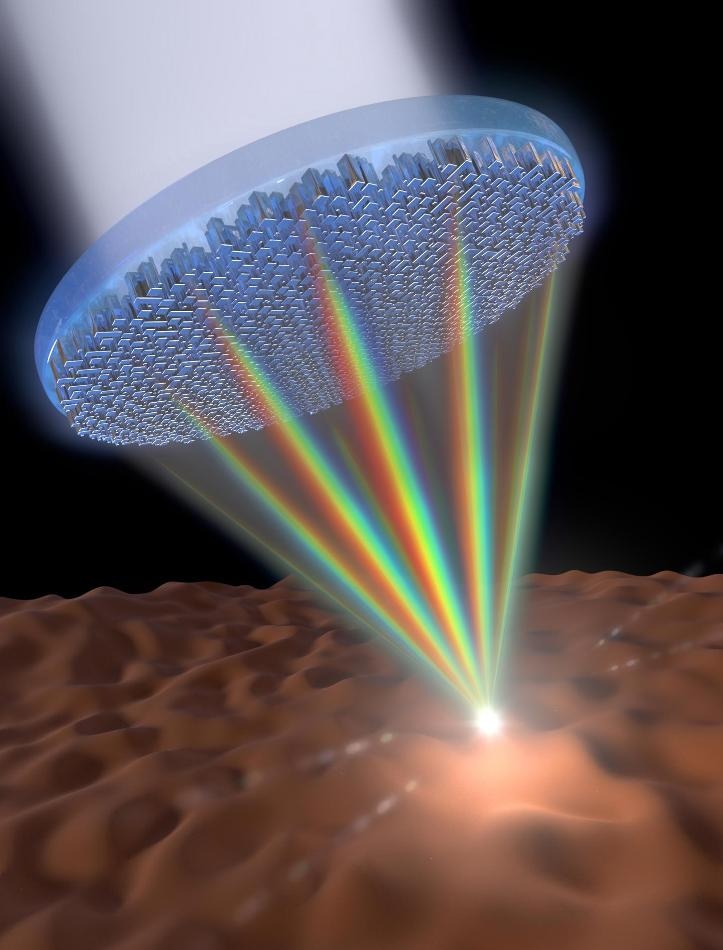Jan 5 2018
Metalenses are flat surfaces using nanostructures for the purpose of focusing light, and they look propitious to transform the field of optics by substituting the curved, bulky lenses adopted at present in optical devices with a simple, flat surface. However, the metalenses are restricted by the spectrum of light they can focus optimally.
At present, a research team from the Harvard John A. Paulson School of Engineering and Applied Sciences (SEAS) has created the first ever single lens with the ability to focus the entire visible light spectrum (including white light) in a single spot at ever higher resolution. This has been accomplished in traditional lenses only by stacking multiple lenses.
 This flat metalens is the first single lens that can focus the entire visible spectrum of light—including white light—in the same spot and in high resolution. It uses arrays of titanium dioxide nanofins to equally focus wavelengths of light and eliminate chromatic aberration. CREDIT: Jared Sisler/Harvard SEAS.
This flat metalens is the first single lens that can focus the entire visible spectrum of light—including white light—in the same spot and in high resolution. It uses arrays of titanium dioxide nanofins to equally focus wavelengths of light and eliminate chromatic aberration. CREDIT: Jared Sisler/Harvard SEAS.
The study has been reported in the Nature Nanotechnology journal.
It is highly difficult to focus the entire visible spectrum including the white light, that is, combination of all the colors in the spectrum, because each wavelength passes through materials at distinct speeds. For instance, compared to the blue wavelengths, the red wavelengths pass through glass faster, hence both the colors will reach the same location at distinct times, leading to distinct foci. This results in image distortions called as chromatic aberrations.
Optical instruments and cameras include multiple curved lenses of disparate thicknesses and materials to fix these aberrations, naturally adding to the bulk of the device.
Metalenses have advantages over traditional lenses. Metalenses are thin, easy to fabricate and cost effective. This breakthrough extends those advantages across the whole visible range of light. This is the next big step.
Federico Capasso, Vinton Hayes Senior Research Fellow, Electrical Engineering, SEAS
The intellectual property related to this study has been protected by the Harvard Office of Technology Development (OTD), which is looking into commercialization opportunities.
The metalenses created by Capasso and his colleagues include arrays of titanium dioxide nanofins to equally focus light wavelengths and remove chromatic aberration. Earlier research showed that distinct light wavelengths can be focused however at distinct distances by optimizing the width, shape, height, and distance of the nanofins. In the most recent design, the scientists developed units of paired nanofins that simultaneously regulate the speed of distinct light wavelengths. The paired nanofins regulate the refractive index on the metasurface and are adapted to create distinct time delays for the light moving through distinct fins, making sure that all wavelengths attain the focal spot at the same instance.
One of the biggest challenges in designing an achromatic broadband lens is making sure that the outgoing wavelengths from all the different points of the metalens arrive at the focal point at the same time. By combining two nanofins into one element, we can tune the speed of light in the nanostructured material, to ensure that all wavelengths in the visible are focused in the same spot, using a single metalens. This dramatically reduces thickness and design complexity compared to composite standard achromatic lenses.
Wei Ting Chen, Postdoctoral Fellow, SEAS
“Using our achromatic lens, we are able to perform high quality, white light imaging. This brings us one step closer to the goal of incorporating them into common optical devices such as cameras,” stated Alexander Zhu, co-author of the paper.
In the future, the goal of the team is to scale up the lens, to a diameter of nearly 1 cm. This will widen the application prospective, for example, applications in virtual and augmented reality.
Vyshakh Sanjeev, Mohammadreza Khorasaninejad, Zhujun Shi, and Eric Lee coauthored the study. The Air Force Office of Scientific Research partially supported the study. The study was carried out in part at the Center for Nanoscale Systems (CNS), a member of the National Nanotechnology Coordinated Infrastructure (NNCI), supported by the National Science Foundation.